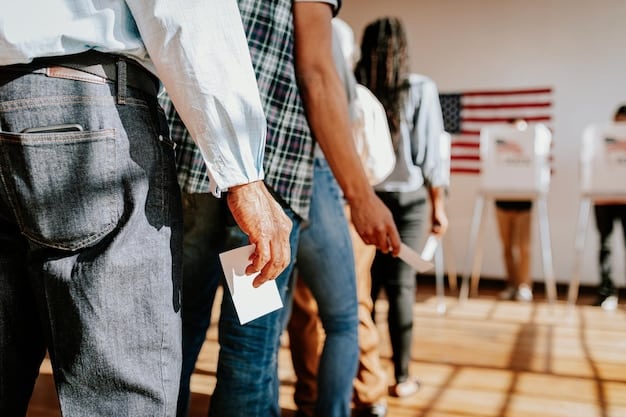Latest Developments in US Voting Rights Fight: A 2025 Update

The latest developments in the fight for voting rights in the US include ongoing legal battles against restrictive voting laws, federal legislative efforts to expand voting access, and grassroots movements advocating for fair and equitable elections.
The struggle for voting rights in the United States is a long and complex one, marked by periods of progress and setbacks. Staying informed about what are the latest developments in the fight for voting rights in the US is crucial for understanding the current state of democracy and how to engage in shaping its future. This article will delve into recent changes, challenges, and ongoing efforts to ensure fair and equal access to the ballot box for all citizens.
Current Legislative Landscape and Voting Rights
The legislative arena is a key battleground in the fight for voting rights. Various bills and laws are proposed and enacted at both the federal and state levels, aiming to either expand or restrict access to voting. Understanding the current legislative landscape is vital for comprehending the challenges and opportunities facing voting rights advocates.
Federal Legislation: The John Lewis Voting Rights Advancement Act
One of the most significant pieces of federal legislation aimed at protecting voting rights is the John Lewis Voting Rights Advancement Act. This act seeks to restore key provisions of the Voting Rights Act of 1965, which were weakened by Supreme Court decisions. Specifically, it aims to update the formula used to determine which states and jurisdictions with a history of discrimination must obtain federal preclearance before making changes to their voting laws.
State-Level Voting Restrictions
While federal legislation aims to expand voting access, many states have been enacting laws that restrict it. These restrictive measures often include stricter voter ID requirements, limitations on early voting and absentee voting, and purges of voter rolls. Understanding these state-level restrictions is essential for assessing the overall impact on voting rights.
- Voter ID Laws: Many states have implemented strict voter ID laws requiring specific forms of identification to cast a ballot, which can disproportionately affect minority, low-income, and elderly voters.
- Early Voting Limitations: Some states have reduced the number of days or hours for early voting, making it more difficult for people with inflexible work schedules or limited transportation to vote.
- Absentee Voting Restrictions: Stricter rules on absentee voting, such as requiring specific excuses or limiting drop-off locations, can hinder voter participation, especially during public health crises.
- Voter Roll Purges: Aggressive purging of voter rolls can lead to eligible voters being removed from the rolls, often without their knowledge.
The legislative landscape surrounding voting rights is constantly evolving, with ongoing debates and legal challenges at both the federal and state levels. Monitoring these developments is crucial for understanding the current state of voting rights and the potential impact on future elections.
Legal Battles and Court Decisions Affecting Voting Rights
Legal battles play a pivotal role in shaping the landscape of voting rights. Court decisions can either uphold or strike down laws and policies that impact voting access. These legal challenges often focus on allegations of discrimination, violations of the Voting Rights Act, or constitutional issues related to voting rights.
Supreme Court Rulings on Voting Rights
The Supreme Court has made several significant rulings on voting rights over the years, some of which have had a profound impact on the current legal landscape. Landmark cases such as Shelby County v. Holder (2013) have weakened key provisions of the Voting Rights Act, leading to increased efforts to restrict voting access at the state level.
Challenges to State Voting Laws
Many state voting laws have faced legal challenges alleging that they discriminate against minority voters or violate the Constitution. These lawsuits often target restrictive voter ID laws, limitations on early voting, and other measures that make it more difficult for certain groups of people to vote. The outcomes of these cases can have significant implications for voter access and election integrity.
- Voter ID Challenges: Legal challenges to voter ID laws often argue that they disproportionately affect minority and low-income voters who may not have the required forms of identification.
- Redistricting Lawsuits: Lawsuits challenging gerrymandered redistricting maps can lead to court-ordered redrawings that create more fair and competitive districts.
- Voting Rights Act Cases: Lawsuits brought under Section 2 of the Voting Rights Act allege that specific voting practices or procedures discriminate against minority voters.
Court decisions can have a lasting impact on voting rights, either by upholding or striking down laws that affect voter access. The outcomes of these legal battles often shape the political landscape and influence the balance of power in government.

Grassroots Movements and Advocacy Efforts
Grassroots movements and advocacy groups play a vital role in the fight for voting rights. These organizations work to educate and mobilize voters, advocate for policy changes, and challenge discriminatory voting practices. Their efforts are essential for ensuring that all citizens have fair and equal access to the ballot box.
Voter Education and Mobilization
Many grassroots organizations focus on voter education and mobilization, working to register new voters, inform people about their voting rights, and encourage them to participate in elections. These efforts often target historically disenfranchised communities and aim to increase voter turnout among underrepresented groups.
Advocacy for Policy Changes
Advocacy groups work to influence policy changes at the local, state, and federal levels. They lobby lawmakers, organize protests and rallies, and launch public awareness campaigns to promote voting rights reforms. Their efforts can lead to the passage of laws that expand voting access and protect against discrimination.
- Get Out the Vote (GOTV) Campaigns: Grassroots organizations conduct GOTV campaigns to encourage registered voters to turn out and vote on Election Day.
- Voter Registration Drives: These drives focus on registering new voters, particularly in communities with low voter registration rates.
- Legal Support for Voters: Some organizations provide legal assistance to voters who encounter problems or barriers to voting.
Grassroots movements and advocacy efforts are essential for empowering voters, defending voting rights, and promoting democratic participation. Their work can help to ensure that all citizens have a voice in shaping the future of their communities and their country.
The Impact of Technology on Voting Access and Security
Technology is playing an increasingly significant role in voting, with innovations such as online voter registration, electronic voting machines, and digital voter education tools. While technology can enhance voter access and convenience, it also raises concerns about election security and potential for fraud.
Online Voter Registration
Many states now offer online voter registration, making it easier for people to register to vote from the comfort of their own homes. This can increase voter registration rates, particularly among younger and more tech-savvy populations.
Electronic Voting Machines
Electronic voting machines have become widely used in elections, offering the potential for faster and more accurate vote counting. However, concerns about the security and reliability of these machines have led to calls for stricter regulations and audits.

Addressing Cybersecurity Threats
The increasing reliance on technology in elections has raised concerns about cybersecurity threats, such as hacking, voter data breaches, and disinformation campaigns. Efforts to address these threats include enhancing cybersecurity measures, conducting regular audits of voting systems, and educating voters about misinformation.
- Cybersecurity Audits: Regular audits of voting systems can help identify and address vulnerabilities to cyberattacks.
- Voter Data Protection: Measures to protect voter data from breaches and misuse are essential for maintaining voter confidence in the integrity of elections.
- Combating Disinformation: Efforts to combat disinformation and promote media literacy can help voters make informed decisions based on accurate information.
Technology has the potential to both enhance and undermine voting access and security. Careful planning and strong safeguards are needed to ensure that technology is used to promote fair, accurate, and secure elections.
Efforts to Combat Voter Suppression
Voter suppression refers to efforts to prevent eligible voters from casting their ballots. These efforts can take many forms, including restrictive voting laws, gerrymandering, and targeted voter intimidation. Combating voter suppression is essential for ensuring that all citizens have equal access to the ballot box.
Legal Challenges to Restrictive Laws
One of the most effective ways to combat voter suppression is through legal challenges to restrictive voting laws. These lawsuits argue that such laws discriminate against minority voters or violate the Constitution, and seek to have them struck down by the courts.
Promoting Fair Redistricting
Gerrymandering, the practice of drawing electoral district boundaries to favor one political party or group, can suppress the voting power of certain communities. Efforts to promote fair redistricting, such as independent redistricting commissions, can help to ensure that all voters have an equal voice in elections.
Protecting Against Voter Intimidation
Voter intimidation, such as harassing or threatening voters at polling places, can discourage people from voting. Efforts to protect against voter intimidation include enforcing laws that prohibit such behavior and providing support to voters who experience it.
- Independent Redistricting Commissions: These commissions are designed to draw electoral district boundaries in a fair and impartial manner, free from political influence.
- Enforcement of Anti-Intimidation Laws: Strict enforcement of laws that prohibit voter intimidation can deter such behavior and protect voters’ rights.
- Voter Protection Hotlines: Voter protection hotlines provide assistance to voters who encounter problems or barriers to voting, including incidents of intimidation or harassment.
Combating voter suppression requires a multifaceted approach, including legal challenges, policy reforms, and grassroots activism. By working together, advocates can help to ensure that all citizens have fair and equal access to the ballot box.
The Role of Civic Education in Promoting Voting Rights
Civic education, which teaches citizens about their rights and responsibilities in a democracy, plays a vital role in promoting voting rights. By educating people about the importance of voting and how to participate in elections, civic education can increase voter turnout and strengthen democratic participation.
Educating Students About Voting Rights
Schools and educational institutions can play a key role in educating students about voting rights and the importance of civic engagement. Curricula that cover the history of voting rights struggles, the role of elections in a democracy, and the importance of civic participation can empower students to become active and informed voters.
Community-Based Civic Education Programs
Community-based civic education programs can provide adults with the knowledge and skills they need to participate effectively in elections. These programs can cover topics such as voter registration, voting procedures, and candidate information.
Promoting Media Literacy
Media literacy, the ability to critically evaluate and analyze information from various sources, is essential for voters to make informed decisions. Civic education programs can teach people how to identify misinformation, distinguish between reliable and unreliable sources, and make informed judgments about political issues.
- Curriculum Development: Schools can incorporate voting rights education into their curricula to teach students about the importance of civic engagement.
- Workshops and Seminars: Community organizations can offer workshops and seminars on voting rights and civic participation for adults.
- Online Resources: Online resources, such as websites and videos, can provide voters with information about their rights and how to participate in elections.
Civic education is a powerful tool for promoting voting rights and strengthening democratic participation. By educating citizens about their rights and responsibilities, civic education can help to create a more informed and engaged electorate.
| Key Point | Brief Description |
|---|---|
| 📜 Federal Legislation | Efforts like the John Lewis Voting Rights Advancement Act aim to restore key protections. |
| ⚖️ Legal Battles | Court decisions shape voting rights, with Supreme Court rulings having significant impacts. |
| 🌱 Grassroots Movements | Organizations mobilize voters and advocate for policies to expand voting access. |
| 🛡️ Voter Suppression | Combating efforts aimed at preventing eligible voters from casting their ballots. |
Frequently Asked Questions (FAQ)
▼
The John Lewis Voting Rights Advancement Act seeks to restore and update key provisions of the Voting Rights Act of 1965, which were weakened by Supreme Court decisions. It aims to ensure that states with a history of discrimination obtain federal preclearance before making changes to their voting laws.
▼
State-level voting restrictions, such as stricter voter ID laws and limitations on early voting, can disproportionately affect minority, low-income, and elderly voters, making it more difficult for them to exercise their right to vote.
▼
Grassroots movements and advocacy groups work to educate and mobilize voters, advocate for policy changes, and challenge discriminatory voting practices, ensuring that all citizens have fair and equal access to the ballot box.
▼
Technology can enhance voter access, such as through online voter registration, but it also raises concerns about election security and potential for fraud, requiring careful planning and strong safeguards.
▼
Civic education teaches citizens about their rights and responsibilities in a democracy, increasing voter turnout and strengthening democratic participation by educating people about the importance of voting and how to participate in elections.
Conclusion
The fight for voting rights in the US is an ongoing process, marked by both progress and challenges. By staying informed about the latest developments, engaging in advocacy efforts, and promoting civic education, individuals and communities can contribute to a more fair and equitable democracy where every citizen has the opportunity to exercise their right to vote.





